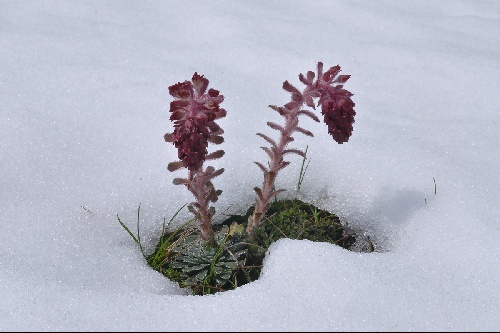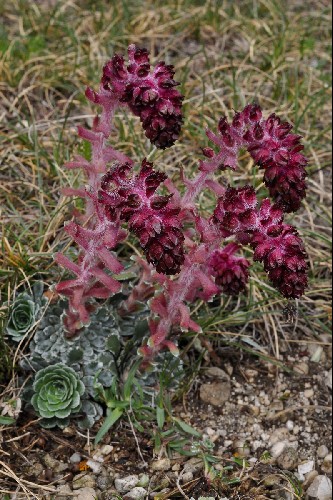Authors:
Two distinct subspecies are recognised. Subsp. grisebachii, syn. S. grisebachii. Typically it produced a few, flat, grey-green rosettes 5-8cm in diameter with heavily lime-marked spathulate leaves 2.5-4cm long. From these arise 15-25cm high flowering stems which carry numerous 1.5-2cm long recurved stem leaves and fifteen to twenty-five nodding flowers. The petals are short, 2mm long, purple and almost invisible, but the stem leaves and inflorescences are covered by a felt of crimson tipped glandular hairs which create a decorative effect. The most widely cultivated clone is 'Wisley' a selected form from the wild. This makes an extra sturdy inflorescence with very broad, recurved stem leaves of a particularly rich crimson colour. Widely cultivated as a favourite alpine house plant, it requires some skill to build up a large, well-flowered plant as it is somewhat parsimonious in its production of new rosettes. Plants in the wild often consist of no more than three to four rosettes. It needs a free-draining, gritty soil but with plenty of humus. Central and southern Macedonia, Albania and northern Greece. S. f.-a. subsp. federici-augusti is now the botanically accepted name for S. porophylla subsp. montenegrina. It is smaller than subsp. grisebachii with flat rosettes 2-4cm in diameter and grey-green spathulate leaves l-2cm long and 3-4mm in width. From these arise 12-20cm high flowering stems. The filaments of the anthers are two to two and a half times the length of the anthers. (In subsp. grisebachii they are approximately the same length).
Not often cultivated as it is not as spectacular, but requires the same cultural conditions. Yugoslavia, Macedonia and Albania.


Sign up for our newsletter to receive our monthly update direct to your inbox. Featuring our latest articles and news.
Built by Atomic Smash

